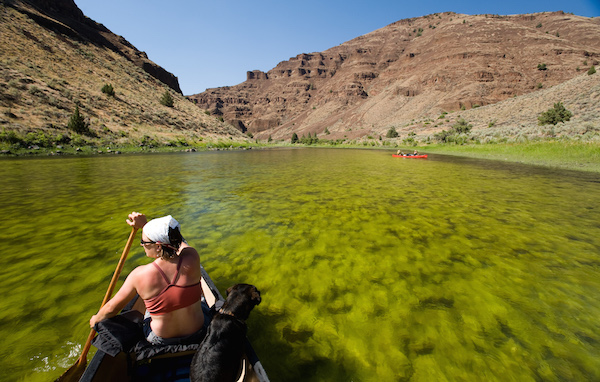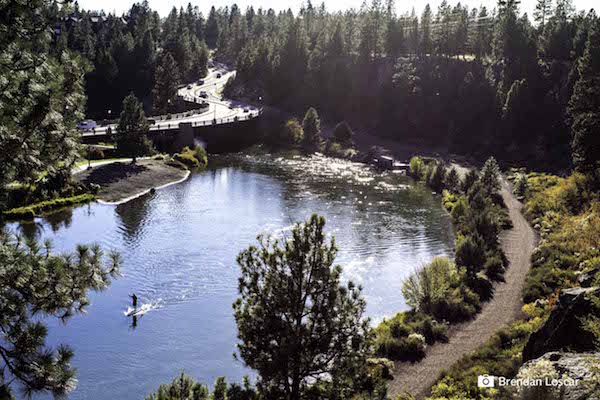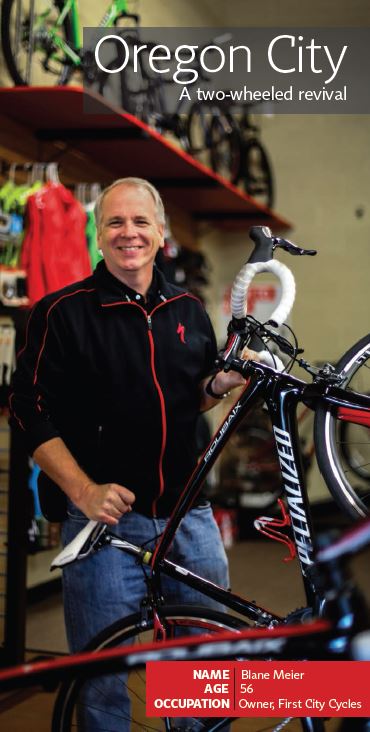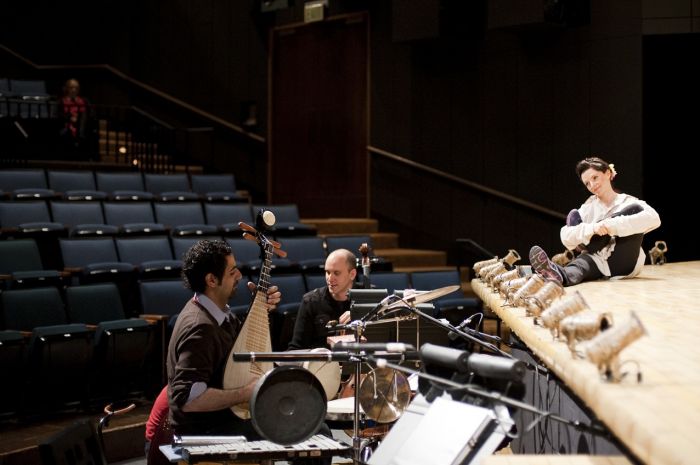written by Mackenzie Wilson | featured photo by Eric Guth
If you love extreme fun, Oregon is your perfect playground. Kiteboarding? Rock climbing? Mountain biking? You got it. If you want something a bit more relaxing, however, pull up anchor and go kayaking, canoeing or standup paddleboarding. From comfort-zone cruising to thrilling rapids, Oregon has the lakes and rivers to make it happen. Here are some of our picks for a few of the most diverse places to paddle in Oregon.
Point-to-Point Adventures
Willamette River Waterway
The Willamette River Waterway is a fantastic option for your first multiday trip. Travis Williams, executive director of the Willamette Riverkeeper, calls the 200-mile stretch of the Willamette River between Eugene and Portland an “incredibly underused recreational resource, which for 70 percent of Oregonians is within a thirty-minute drive.” Besides some Class II rapids near Eugene, where most people put in for multiday trips, the water is mainly flat. Most camping along the river is ‘leave no trace,’ so plan to pack out whatever you bring in.

John Day River
During May and June, before water levels decrease substantially, the John Day is an ideal place for beginners to start a multiday trip. If you want, you can walk around the only Class III rapid on the 281-mile stretch called the Clarno Rapid. David Trageser of Alder Creek Kayak & Canoe said that even though many of the sections are tame, “The last thing anyone wants is to get into trouble because they underestimate what even a class I or II river section can do.” Unless there’s a good mix of experience, hiring a guide is the safest option.
Rogue River
If your heart craves a river with unparalleled beauty, head to the Rogue. It’s one of the original eight rivers protected under the ‘Wild and Scenic Rivers Act’ created by Congress in 1968. Known for its phenomenal whitewater, the Rogue has a mix of rapids up to Class V and some calm areas for flatwater kayaking. For beginners, a guide is necessary. The only instructional-based kayak school that runs the Wild and Scenic section of the Rogue is Sundance Kayak School. “We always have a raft support for our kayak schools so if at any moment you’re not ‘feeling it,’ you can stop kayaking and ride on a raft,” said Lori Turbes, Sundance’s co-owner.
Scenic & Remote Paddling
Hosmer Lake
Hosmer Lake is an absolute stunner. Don’t be fooled by what you see from the parking area. A few minutes of paddling through a winding channel, and you’ll emerge into aqua blue water. Although it’s less than five miles away from tourist and local favorite, Elk Lake, Hosmer Lake is still considered remote. That said, the larger-than-life mountain views of Broken Top, Mt. Bachelor and South Sister, combined with the lake’s crystal-clear water, ensure this High Cascade Lake is a little-kept secret. During the summer, arrive early. Parking is limited.
Owyhee Reservoir
Want to get away from it all? The Owyhee Reservoir in Eastern Oregon offers some secluded paddling. Just shy of 80 miles west of Boise, Idaho, Owyhee Lake State Park makes for a better weekend getaway than just a day trip. Starting in mid-April, two campgrounds, McCormack and Indian Creek, are open and provide more than fifty campsites and even a few primitive tents and tipis.
Social Paddling

Deschutes River | Bend
Few sights scream ‘a good time’ like the brightly colored flags flanking the bridge in Bend’s Old Mill District. When you add a fleet of people making their way up and down the Deschutes River below, it’s an urban-meets-nature experience that’s hard to beat. Another option for kayaking or paddleboarding the Deschutes near Bend is the stretch of flatwater between Dillon and Benham Falls. Laurel Brauns, marketing director at Tumalo Creek Kayak & Canoe, said that “open meadows expose views of the Cascades in the distance, and the water is a clear shade of aquamarine, providing plenty of opportunities to check out the fish.”
Elk Lake
Elk Lake is known for its mountain views, close proximity to Bend and Sunriver and for being swamped with tourists. Sailors, paddleboarders, canoers and kayakers slip by one another as laughter echos across the water. The thing about Elk Lake is that most people only discover a portion of the lake during their visits. Instead of taking the well-marked path and parking at the resort, try driving a little farther. Take Forest Service Road 4625 and, in less than two-miles, you can put your kayak or SUP in at Little Fawn Campground. “There’s a beautiful grey sand beach with views of the Cascades and a calm little bay that’s sheltered from the wind,” said Brauns of this less-visited side of Elk Lake. At Little Fawn, you can camp and explore a part of the lake most visitors never touch.
Family Friendly
Clear Lake
It’s clear and cold here at the headwaters of the McKenzie River. The only people you’ll see submerged in the water here will be scuba divers, protected from the cold by their wetsuits. The lake’s water is a bone-chilling 35 to 43 degrees year-round. The water may be unswimmable, but you can enjoy pristine views from your canoe or kayak. Trees submerged in hundreds of feet of crystal clear flatwater will shape lasting memories.
Deschutes River | Sunriver
Sometimes it’s tough to find a destination that’s going to make everyone in your family happy. In Sunriver, a day on the Deschutes River is perfect for a wide range of adventures. Your biggest decision will be how you’re getting to and from the river. You can go it alone and leave an additional car at a takeout or hire a shuttle service to drop you off and pick you up. The latter option has its perks. Jon Wiley, the owner of Good 2 Go in Sunriver said if you want to get away from the crowds, he can get you access to the Little Deschutes tributary. Public access is limited to the Little Deschutes, but Good 2 Go can drop you off at an exclusive access point on private property where you can float by Crosswater Golf Course, under willow trees and possibly past a herd of elk.”
Wildlife Encounters
Klamath Lake
Dotted with colorful sailboats and plenty of wildlife, Klamath Lake is a visually stimulating, flatwater paddle. Located between Chiloquin and Klamath Falls, the lake can be quite windy. Jen Roe, co-owner of ROE Outfitters, tells her clients to stay in the more wind-protected northwest and southwest sections of the lake. As seasons change, so do the opportunities for viewing wildlife. Roe said during spring and fall, migrating waterfowl make a stopover at the lake. From your kayak, you can catch a glimpse of giant white pelicans, osprey, bald eagles, great blue herons, otters and turtles. Whether you choose to go it alone or hire a naturalist to guide you, your best bet for seeing wildlife is to go early in the morning or around sunset. “Lots of birds are like us,” said Roe. “They need a siesta in the heat of the day.”
Siltcoos River
The Siltcoos River, also known as the Siltcoos Canoe Trail, flows between Florence and Coos Bay and is surrounded by the Oregon Dunes National Recreation Area. Birders love the lower section, which takes paddlers past the nesting habitat of the endangered Snowy Plovers. The beaches near their nesting areas are off-limits from March 15 through September 15, but kayakers are still allowed. Even beginner paddlers could complete the three-mile stretch of flatwater in half a day.
Scappoose Bay
From Portland, a quick, thirty-minute scenic drive on Highway 30 will get you here—a 300-acre flatwater area for kayaking, standup paddleboarding and canoeing on the very lower end of the Willamette. The bay is home to a diverse species of birds, including bald eagles. In spring, you can paddle close enough to see them nesting. Because the bay is tidal, it’s possible to get stuck—especially during the summer months when the water level is lower in general.








